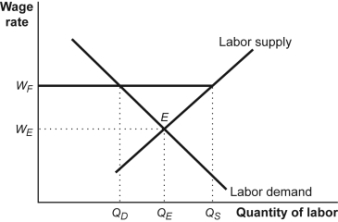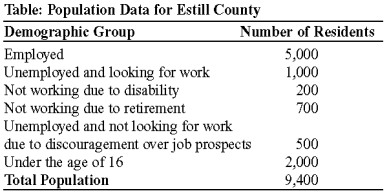A) 80,000
B) 100,000
C) 110,000
D) 200,000
Correct Answer

verified
Correct Answer
verified
True/False
Counted among the unemployed are underemployed people, who cannot find a job working as many hours as they wish.
Correct Answer

verified
False
Correct Answer
verified
Multiple Choice
You are a college student and not working or looking for work. You are:
A) unemployed.
B) in the labor force but not employed.
C) not part of the labor force.
D) counted in the labor force as underemployed.
Correct Answer

verified
Correct Answer
verified
Multiple Choice
Use the following to answer questions
Figure: The Effect of a Minimum Wage  -(Figure: The Effect of a Minimum Wage) Look at the figure The Effect of a Minimum Wage. Suppose the labor market is in equilibrium at E when the government imposes a minimum wage of WF. The quantity of labor supplied may_____, resulting in structural unemployment.
-(Figure: The Effect of a Minimum Wage) Look at the figure The Effect of a Minimum Wage. Suppose the labor market is in equilibrium at E when the government imposes a minimum wage of WF. The quantity of labor supplied may_____, resulting in structural unemployment.
A) decrease to QD
B) stay at QE
C) increase to QS
D) stay at WE
Correct Answer

verified
Correct Answer
verified
Multiple Choice
The labor demand curve is negatively sloped because:
A) more people are willing to work at low wages than at high wages.
B) more people are willing to work at high wages than at low wages.
C) employers are willing to hire more people at low wages.
D) employers are willing to hire more people at high wages.
Correct Answer

verified
Correct Answer
verified
Multiple Choice
Deflation is:
A) a decrease in unemployment.
B) a decreasing aggregate price level.
C) a decline in wages.
D) a recession.
Correct Answer

verified
Correct Answer
verified
Essay
Kelli is a server at a casual restaurant in a small town. In each of the following situations, explain Kelli's type of unemployment. a. The local economy is in a minor recession and the restaurant lays Kelli off. The owner assures her that she will be rehired when business picks up again. b. A large factory, the major employer in the town, permanently closes, and this hurts all restaurants in town. The restaurant fires Kelli because the owner can only afford to stay open on the weekends. c. Kelli is dissatisfied with her schedule at the restaurant and quits her job. She is qualified to work at other restaurants and immediately begins to send her résumé to restaurants all over town.
Correct Answer

verified
a. This is cyclical unemployment, due to the temporary dip in the business cycle.
b. This is structural unemployment, due to a permanent decrease in the demand for this labor. At the current wage, there is now a surplus of labor.
c. This is frictional unemployment; she is voluntarily seeking a better match for her skills and needs in the labor market.
Correct Answer
verified
Multiple Choice
The real wage is the wage rate _____ the price level.
A) plus
B) minus
C) divided by
D) multiplied by
Correct Answer

verified
Correct Answer
verified
Multiple Choice
Two primary goals for macroeconomists are price stability and:
A) no unemployment.
B) no frictional unemployment.
C) low unemployment.
D) no structural unemployment.
Correct Answer

verified
Correct Answer
verified
Multiple Choice
High rates of inflation often result in people spending inordinate amounts of time trying to make transactions and finding ways to keep the real value of their money from decreasing. This is an example of _____ costs.
A) shoe-leather
B) menu
C) efficiency wage
D) unit-of-account
Correct Answer

verified
Correct Answer
verified
Multiple Choice
Economists generally agree that sufficiently high minimum wage laws:
A) cause unemployment.
B) help lower the structural unemployment rate.
C) decrease the labor force participation rate.
D) make an opportunity for discouraged workers.
Correct Answer

verified
Correct Answer
verified
Multiple Choice
During rapid price inflation, firms must frequently change prices. The cost of changing listed prices is known as the _____ cost.
A) menu
B) real interest rate
C) shoe-leather
D) unit-of-account
Correct Answer

verified
Correct Answer
verified
Multiple Choice
Use the following to answer questions  -(Table: Employment Data) Look at the table Employment Data. The labor force is:
-(Table: Employment Data) Look at the table Employment Data. The labor force is:
A) 33 million.
B) 32 million.
C) 31 million.
D) 22 million.
Correct Answer

verified
Correct Answer
verified
Multiple Choice
Frictional unemployment exists because of all of the following reasons EXCEPT:
A) that new jobs are continually being created.
B) that some old jobs are always being destroyed.
C) that new workers are always entering the labor market.
D) for the minimum wage.
Correct Answer

verified
Correct Answer
verified
Multiple Choice
Suppose that the nominal rate of interest is 7% and the inflation rate is 3%. The real rate of interest is:
A) 3%.
B) 4%.
C) 10%.
D) 7%.
Correct Answer

verified
Correct Answer
verified
Multiple Choice
The sum of the frictional and structural rates of unemployment is the:
A) cyclical rate of unemployment.
B) cyclical rate of employment.
C) natural rate of unemployment.
D) natural rate of employment.
Correct Answer

verified
Correct Answer
verified
Multiple Choice
Use the following to answer questions :  -(Table: Population Data for Estill County) Look at the table Population Data for Estill County. What is the unemployment rate?
-(Table: Population Data for Estill County) Look at the table Population Data for Estill County. What is the unemployment rate?
A) 64%
B) 48%
C) 17%
D) 6%
Correct Answer

verified
Correct Answer
verified
Multiple Choice
Suppose that Allison has an accounting degree, but she lost her job two months ago when her company merged with another firm. Allison hasn't been able to find another accounting job, so she has taken a part-time job as a sales clerk at a clothing store. The Bureau of Labor Statistics classifies Allison as:
A) a marginally attached worker.
B) a discouraged worker.
C) underemployed.
D) unemployed.
Correct Answer

verified
Correct Answer
verified
Multiple Choice
When labor unions successfully bargain for wage rates that are _____ than the equilibrium wage rate, they may cause _____.
A) lower; frictional unemployment.
B) equal to; shortages in that labor market.
C) higher than; an increase in structural unemployment.
D) higher than; shortages in that labor market.
Correct Answer

verified
C
Correct Answer
verified
Multiple Choice
The population of discouraged workers causes the:
A) actual unemployment rate to increase when the workers are not included in the unemployment calculation.
B) actual unemployment rate to understate the true level of unemployment.
C) actual unemployment rate to overstate the true level of unemployment.
D) natural rate of unemployment to increase.
Correct Answer

verified
Correct Answer
verified
Showing 1 - 20 of 351
Related Exams